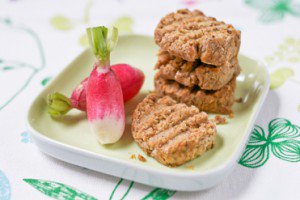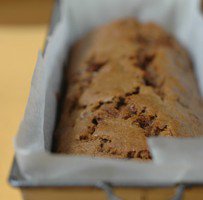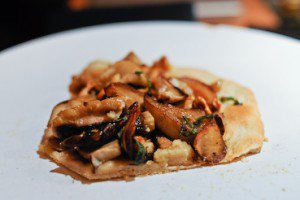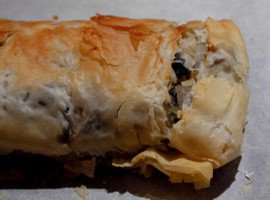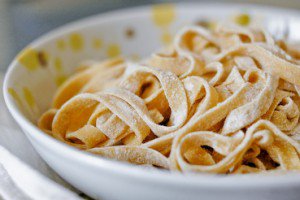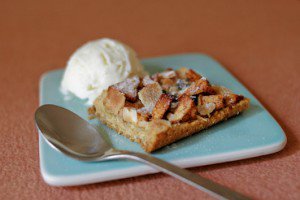
[Scones au Gouda Vieux et Poires Séchées]
Before we begin, I would like to address the scone/biscuit question. To Americans, a biscuit is the hand-held version of a quick bread, leavened with baking powder. Usually round and savory, the American biscuit may be served in place of bread to accompany a main course, especially if said main course involves a gravy component. The closest equivalent the British and the French can think of is the scone, thus named in honor of the Scottish Coronation Stone I believe, but most scones I’ve come across are sweet — though subtly so — and served for breakfast or tea with clotted cream and jam (yum). There are scones in America, too, but in my experience they are most often triangular, sweet as a muffin, and meant to be eaten on their own, sans spread.
To the British and the French, who have such a long history of seeing eye to eye on everything, a biscuit (from the Old French bis cuit, twice baked) is a thin, crisp, and usually round confection that Americans would call a cookie, a term that the French themselves use for what they think of as American-style biscuits — round, large, and loaded with chocolate chips.
I am telling you, somebody out there is trying to make the life of the transatlantic food writer more difficult than it really needs to be. In any case, the golden rounds I baked the other day were what I would personally call savory scones, but because I am a very tolerant, live-and-let-live person, I’ll let you decide what name seems the most fitting to you.
The idea for them came as I was leafing through the very refreshing More from ACE Bakery cookbook, which its author, Linda Haynes, sent to me: on page 28 was the picture of a (sweet) oatmeal scone, flavored with dried pears and hazelnuts, sitting side by side with a (savory) cheddar chive biscuit that called for aged white cheddar.
Both sounded very good, but seeing as I had dried pears in a tin box on my counter and a hunk of 36-month-old gouda in my fridge, the two recipes somehow merged in my mind and became aged gouda and dried pear savory scones.
Linda’s biscuit batter recipe produced a sumptuous texture — a crisp shell and a moist, slightly brittle crumb — and the gouda/pear pairing made for a very pleasing balance of flavors, the sweetness of the fruit responding to the discreet pungency of the cheese. We ate some of them with a carrot-cilantro soup while the rest was cut into bite-size pieces to nibble on with a pre-dinner drink the next day, but they would also be perfect for brunch or with a simple salad of greens.
Scones au Gouda Vieux et Poires Séchées
– 180 grams (1 1/3 cup) all-purpose flour
– 3/4 teaspoon baking powder
– a fat pinch of ground piment d’Espelette (substitute any moderately hot ground chili pepper)
– 3/4 teaspoon fleur de sel (substitute kosher salt)
– 75 grams (6 tablespoons) unsalted butter, diced
– 85 grams (1 cup) coarsely grated 36-month-old gouda (substitute another type of aged firm cheese, such as comté, parmesan, or cheddar)
– 20 grams (3 tablespoons) diced dried pears
– 100 ml (7 tablespoons) light (15%) cream
– 1 egg yolk, beaten with a tablespoon fresh water
Makes 9 pieces.
Preheat the oven to 180°C (350°F) and line a baking sheet with parchment paper.
In a medium mixing bowl, combine the flour, baking powder, piment d’Espelette, and salt. Add the butter and rub it into the dry ingredients with the tips of your fingers or a wire pastry blender, until the mixture forms coarse crumbs. Add the cheese and pears, and blend with a fork.
Add the cream and mix it in gently with the fork until the dough comes together — add a tad more cream or ice-cold water if the dough is too dry. Turn the dough out on a lightly floured work surface, gather into a ball, and roll out into a 2-cm-thick (3/4-inch) circle. Cut out circles of dough using a 6-cm (2 1/2-inch) cookie cutter or juice glass and transfer onto the prepared baking sheet, leaving about an inch of space between each. Gather the rest of the dough into a ball and repeat the rolling and cutting steps until you’ve used up all the dough.
Use a pastry brush or the back of a teaspoon to brush the top of the rounds with the egg yolk mixture. Bake for 20 to 25 minutes, until puffy and golden, rotating the baking sheet halfway through the baking. Let cool on a rack for a few minutes and serve. The scones will keep for a few days at room temperature, wrapped tightly in foil. Reheat for five minutes in a warm oven before serving.
[Adapted from More from ACE Bakery, Cheddar Chive Biscuits, page 30.]
Cooking/baking time: 25 min





